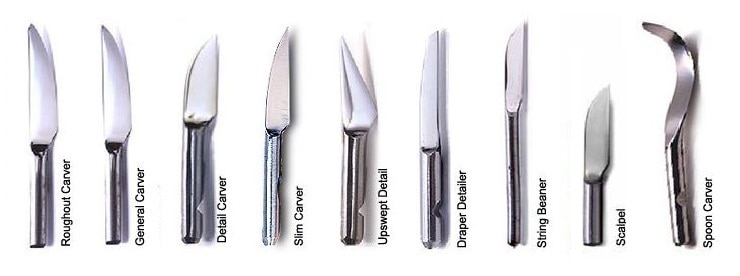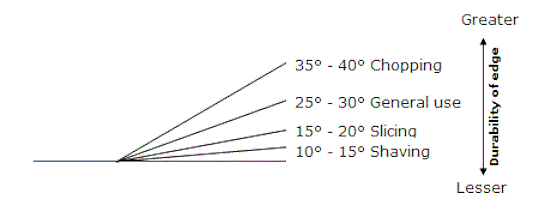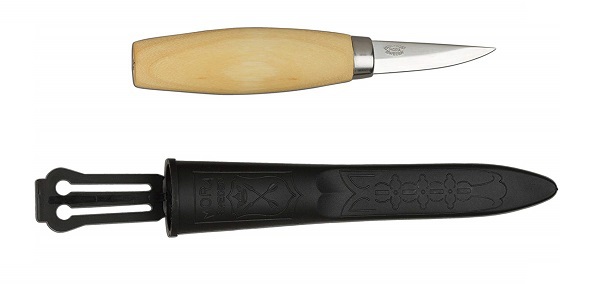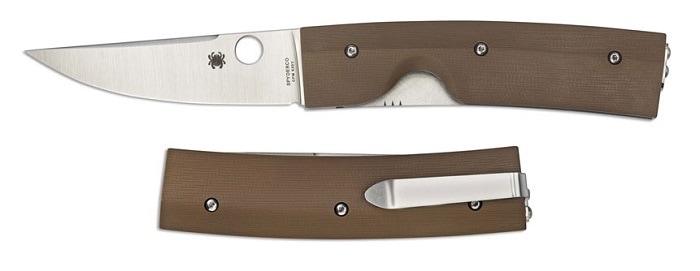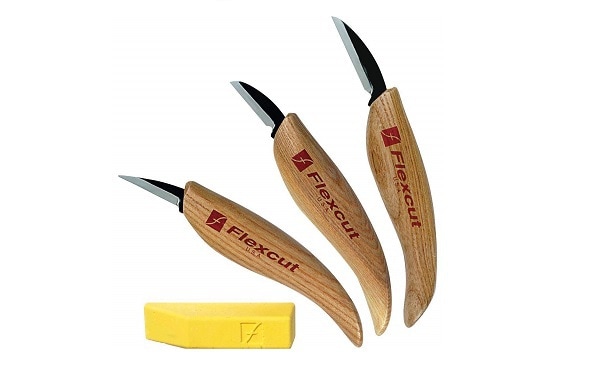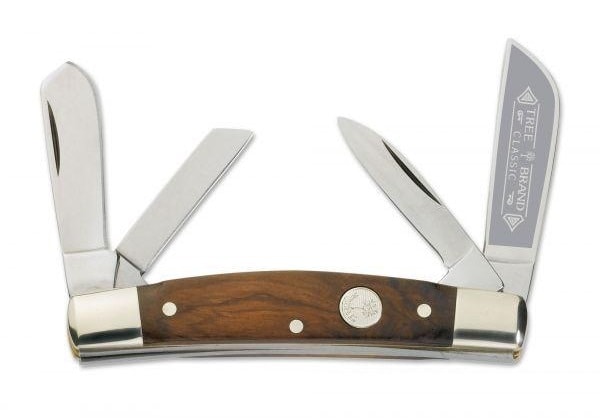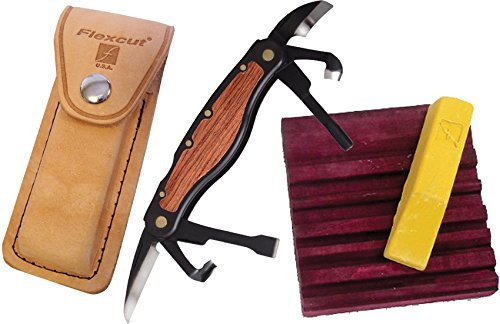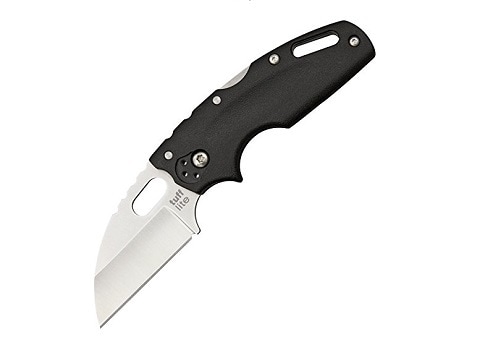If you are new to whittling, having the best whittling knife can make a huge difference in the results one can achieve. Not only will you be able to achieve finer detail in your carvings, the ease of which you can achieve those details is greatly improved. Learn more below about what makes a knife great for whittling.
Like most folks who decide to invest in a decent whittling knife or even a complete set of whittling knives, I had been whittling casually for years. Ever since my days as a Boy Scout, I can recall sitting around the campfire at the end of the day carving sticks and larger wood pieces into various designs like spears and small animals.
Whittling is such a gratifying activity and it can be both stress-relieving and great to pass the time. I will warn anyone considering picking up whittling that it is highly addictive! This isn’t always a bad thing as I usually gift my wood carvings since they accumulate so quickly and friends and family love receiving them.
If you are committed to the craft and are looking to invest in quality whittling knives that slice through wood effortlessly while maintaining a sharp edge I have put together an incredibly informative guide. With so many years working with wood crafts I have amassed an incredible amount of knowledge about wood carving knives and I am happy to pass that on.
Whittling Knife Guide: How To Choose A Wood Carving Knife
When searching for a whittling knife there aren’t many things to consider which is good since it can make your search a bit easier. Below are all the important aspects of knives made specifically for wood carving. Which brings me to a question I often hear from anyone who wants to learn more about whittling.
What is the difference between whittling and wood carving? The two terms can really be used interchangeably but “whittling” specifically refers to wood carving with a knife whereas “wood carving” is a more broad term that includes both knives and other tools of wood carving like gouges, chisels, and more.
Is a whittling knife different from a wood carving knife? Not at all, as I said above whittling is wood carving but done exclusively by a knife. Knives used for whittling have evolved and improved over time to be better wood carvers but as a general rule, wood carving knives and whittling knives are one and the same. I will note that I personally like to preface that some folks prefer figure carving and detailed carving and others stick to bushcraft whittling projects.
Types of Wood Carving Knives
There are a few different types of wood carving knives commonly used by whittlers. Each type of knife is designed to either be extremely well rounded and versatile in its performance or perform specific tasks much better or easier. It is common for wood carving artists to have several knives at their disposal in various types and styles. This allows us to achieve the best results for a given design.
Personally, I rely on a select few knives that can handle the bulk of my carving but I also have several other knives at my disposal that excel at various tasks that I sometimes encounter. This often includes creating very fine details that need to be carved in tight spaces or removing a lot of material on large pieces quickly.
Common Blade Types of Whittling Knives
Sheepsfoot Knife
A sheepsfoot knife is a blade design for what most people commonly refer to as a wood carving knife. It is designed with a straight cutting edge with the back of the blade dropping down a point at the knife’s edge. These types of whittling knives are made in various lengths and thickness to give wood carvers many options to choose from. The will also vary slightly in shape and are commonly found in the two classes below.
- Roughing Knife: Just as the name suggests, these versions of a wood carving knife are meant to make rough cuts at the beginning of your design creation. The rough knife will usually be a bit larger both in length and thickness. It is designed for removing a lot of material quickly and easily.
- Detail Knife: The detail knife is made a bit smaller with an even finer point and the top of the blade is less round compared to the rough knife. This design allows wood carvers to really make finely detailed carves into the wood. It also allows for working in confined conditions, allowing the end of the knife to make detailed cuts without making unwanted nicks.
Spear Point Knife
Another common shape is a spear point which is more or less the shape of a spear. The blade on this knife raises on the leading edge of the blade and meets the back of the blade about halfway resulting in a symmetrical spear point shape.
This design great for making fine details but can lack the rigidity of the detail versions of a sheepsfoot blade. This usually isn’t an issue unless you are working with hardwoods and trying to remove more material than the knife is intended to.
Chip Carving Knife
Chip carving is typically the removal of wood in chips or chunks that create a pattern. The blades on chip carving knives are specifically designed to make these intended chips. There are several different blades that are suited to making a variety of chips. You can make a bowl or concave chips, sweeping curve shaped chips in more with this style of a wood carving knife.
Spoon/Hook Knife
Spoon or Hook Knives are a made with a curved or hook-shaped blade. These knives are specially designed for spoon carving and excel at hollowing out wood to make bowls, spoons, and others designs requiring deep concave designs like cups. If you want to make these types of wood carvings you will really achieve the best results with a hook knife to make the smooth hollowed out edges. Note that hook knives are made in left and right-handed versions.
Folding Pocket Knife
One can argue that the pocket knife gave rise to the popularity of whittling by its own rise to popularity. While most pockets knives won’t excel at wood carving and there are much better options, there is no denying the accessibility of the pocket knife and the portability.
Most pocket knives are inferior wood carvers due to the metal used in them which are chosen more for durability and corrosion resistance rather than blade sharpness and stiffness. There are some exceptions including Boker and Ross Oar which are some of the best wood carving pocket knives. If you are intent on getting the best pocket knife for whittling look for one with a high carbon steel blade and steer clear of stainless blades as they will not hold a sharp edge.
Gouges
Gouges are another wood carving tool used but are much different from knives. Gouges are more like chisels and are made in a variety of shapes like a “V” or a “U” in various sizes. They are made to gouge wood material rather than slicing it away. I will write more about these another day.
Ultimately the style of whittling knife you choose to work with will come down to personal preference. There are pros and cons of each and everyone has their own style of carving from how they hold the wood to how they hold the knife. Each person will also carve and slice in a motion that feels best for them and in a manner they have the most control. It is important to feel comfortable with the knife you choose and the only way to know this is trying several different ones.
Whittling Knife Blade Material
A knife blade’s material is almost as important as the shape and size. You will find that just about all blades meant for carving wood are made of carbon steel. Sure you can find knife blades in various other materials like titanium, stainless steel, and various other steel alloys, but as a general rule you should always seek out high carbon steel whittling knives.
When carbon is added to iron ore it makes carbon steel. Carbon affects a variety of properties in steel when heat treated in different ways. As the carbon percentage content rises, steel can become harder and stronger through heat treating but that means it becomes less ductile. Below are the steel properties you should be concerned with in regards to wood carving.
Blade Strength/Hardness
A blade’s strength and hardness come from its carbon content and how it was heated treated. Hardness is measured using the Rockwell Scale and a hardness of 58-62 (which is quite hard) on this scale is usually ideal for wood carving. The harder the steel usually means harder to sharpen, but most important is that hard steel will have much greater edge retention that can be maintained by stropping.
The hardness of a blade will determine a blades toughness and strength. A hard blade also makes for a strong blade that will resist bends and permanent deformity but the tradeoff is reduced toughness or its ability to bend and flex without cracking or breaking. Having a reduced toughness of a hard blade is less of an issue with softwoods but it is best to be cautious of exerting to much force when carving hardwoods.
Blade Corrosion Resistance
To make steel corrosion or rust resistant steelmakers will add different metals to the steel but most common is the addition of Chromium. Stainless Steel has a Chromium content that is usually a minimum of 13%. This addition of Chromium will sacrifice edge quality however since stainless steel metals are softer than the typical high carbon steel.
Don’t get caught up in manufacturer’s marketing of stainless steel knives as having a harder blade that maintains a sharper edge is far superior to one that resists corrosion. With proper care and a regular, light application of oil, it is relatively easy to keep your knives from rusting. Plus they will develop a nice patina most appreciate.
When searching for a whittling knife look for a high carbon blade that has a carbon content of 1%-1.5%. This will provide you with a strong blade that will maintain the best edge. It is not always easy to find out the type of steel used in a blade but look for knives made with W1, W2, or O1 tool steel as these are high carbon tool steels. If you really feel like you may need higher corrosion resistance due to the working environment D2 tool steel will have a higher chromium content while still maintaining decent hardness.
Whittling Knife Blade Length & Thickness
If you are wondering “How long should a whittling blade be? there is no perfect answer. Just as in the style of blade you work with, the length of the blade will come down to preference and type of carving you intend to do. It is good practice to have a few whittling knives in various lengths.
Having a variety to work with will ensure you have blades that can remove material efficiently as well as get into the nooks and crannies to create incredible detail in your carvings. As a general rule you will probably feel most comfortable with blades from .75″-1 1/4″ but having a larger rough in knife can be useful as well for large carvings.
The thickness of the blade will provide strength but it will also affect how the blade slices and shaves away material. Thinner blades are better for detail work as it allows for fine shaving of material whereas the thicker blades are great for quickly peeling away larger chunks of material. Blades will range from .025″ to .05″, just remember, blades are not meant for prying and remembering that rule will save even thin blades from damage.
Other Considerations in Whittling Knives
We have already gone over some of the most important aspects of whittling knives but there are a few more details that folks often overlook. The blade grind or edge angle will affect cutting performance. Another big consideration is the comfort of the knife and how the handle fits your hand.
Blade Grind/Edge
A blades grind or the shape of the edge will give a knife a certain cutting characteristic. Different grinds will be better suited to certain jobs whether that is slicing, chiseling, cutting, etc. That said, the best grind for wood carving is the Scandi also known as a Sabre grind. They excel at wood carving because they bring their mass so far down to the blade edge you can actually get a thinner blade profile and still have rigidity.
This grind gives you a thin yet strong blade but also helps in detail carving. Getting wide fast also helps with splitting as it performs like a thicker stocked knife and gives you a greater wedging action. You will also notice how the Scandi Grind is basically like two chisels married together. Fun Fact: Scandi grind gets its name from Scandinavia as this grind was prevalent there due to the heavy influence of wooded terrain and the need for a grind that worked well working with wood.
Finally, the angle at which the grind is made will vastly change the characteristics of a carving knife. Generally, the best grind angle of carving knives is going to be between 10 degrees and 20 degrees. The other benefit of the Sabre/Scandi grind is it is easy to maintain as it is a flat grind and you need only worry about that angle when reworking the edge.
Blade Handle
Handles come in many different shapes and sizes. When carving you may find yourself gripping a whittling knife for hours which can become quite uncomfortable if it does not fit and feel just right. Find a handle grip that feels most comfortable to ensure you minimize any fatigue.
Don’t be afraid to modify the handle either with a little tape to improve the grip even further. You can easily build up a certain part of the grip with tape as well as add a bit of cushion with a few layers of tape. Improving the comfort and feel of your knife handle can certainly contribute to improved carving.
Finally, unless you are buying a set of whittling knives for a young person to learn with, you should definitely avoid knives that have a hilt guard which is a protective guard between the knife and handle. Hilt guards can limit your ability to utilize the whittling knife in a full range of motion.
Whittling Knife Maintenance
Once you have your knife and begin to carve wood with it, it is important that you maintain your new whittling knife to ensure you get a long life out of it with great performance. I won’t go into detail but below the keys to wood carving knife maintenance. Follow these 5 tips and your knife can last a lifetime.
- Use it only for its intended purpose, and stick to wood materials.
- Sharpen your blade when it needs it.
- Stropping and honing should be done after sharpening, as well as periodically even if you haven’t sharpened it.
- Clean and oil your knife regularly to resist corrosion.
- Store your knife protecting the blade in a dry environment.
Now you have a better understanding of what makes a great whittling knife to carve wood and you can set out to find one or even a few that work best for your needs. We have also provided several choices below from the best makers of whittling knives jump into the list now. Lastly, check out our article on wood burning tools as they are an excellent addition to wood carving and enhancing designs.
The Best Whittling Knife – Top 5 Quick Reviews
There are quite a few outstanding whittling knives, and quite a few are made by small knife makers like Pinewood Forge, Cape Forge, Helvie, and more. While those knife makers forge truly great knives, they are mostly small operations and the lead time is usually several weeks to months.
I usually recommend folks start with some of the knives below as they are very accessible and you can get a feel for the style of knife you like instead waiting weeks for a whittling knife you are displeased with. That said, once you develop your preference in knives gives one of those makers a look!
Flexcut Whittling Knives Review
“Best Whittling Knife”
Flexcut whittling knives are one of the first recommendations I make to people wanting to get started in wood carving. The wide availability of whittling knives in many different styles is why some consider it the best whittling knife for beginners who are serious about diving right in. Their line of whittling knives ranges from roughing knives to fine detail knives and even many of the less common specialty options like the pelican knife.
Flexcut knives are made with high carbon steel housed in a comfortable, ergonomic hardwood handle. In my experience, they arrive very sharp and need little to no edge improvement before whittling. These knives are also very affordably priced, especially compared to the boutique knives. This is great for anyone looking to pick up a few different styles to try out.
Finally, Flexcraft is made in America and are usually excellent to their customers. A great selection of whittling knives for both the beginner and experienced wood carver that should last a forever with proper care and maintenance. Click the link for a full list of styles and prices.
Key Features
- Sharp Carbon Steel
- Many available knife styles
- Ergonomic & Comfortable Handle
Morakniv Wood Carving 120 Review
“Best Wood Carving Knife for Versatility”
Morakniv knives are well known by wood carvers as this Swedish knife manufacturer has made quality knives for over a century. These wood carving knives have traditional tapered blade style made of laminated carbon steel and perform like a dream. The nearly 2.5″ blade and the ideal Scandi grind makes it an excellent all-around carving knife.
The Morakniv 120 is large enough to act as a roughing knife but the blade is tapered enough to make easy work of detailing with its thin tip. If you prefer something even larger, the Morakniv 106 has 3.2″ blade and is great for bushcraft enthusiasts.
One of my favorite things about the Morakniv is the large incredibly comfortable handle. I have whittled for hours with a Morakniv with little to no hand fatigue. If you are looking for a great all-purpose whittler, the Morakniv is a favorite of mine to use when I don’t have anything specific in mind I would like to carve. A worthy knife for any collection.
Key Features
- Laminated Carbon Steel
- Simple highly effective design
- High Quality
Spyderco Nilakka G-10 Review
“Great Whittling Knife for Collectors and Enthusiasts”
This is for all of the knife enthusiasts or someone looking for a gift for a knife collector. Spyderco makes some of the best folding knives available and the Nilakka is no exception. Spyderco collaborated with Finnish knifemaker Pokka Tuominen, a world-renowned expert on the traditional puck knife to design this knife. This design was MADE for slicing wood and it looks beautiful doing so.
I preface that this is a great knife for the enthusiast due to its beauty and of course the premium price but it certainly won’t deter everyone from using such a quality yet pricey knife to whittle. With such a great design you expect great performance and it absolutely does.
The full-flat ground bevel and zero-ground edge work with wood effortlessly and the stout handle feels perfect in your hand. One of the most beautiful yet high performing everyday carvers to keep on your person for those spontaneous whittling sessions.
Key Features
- Superior Craftsmanship
- Excellent Hand Feel
- Pukko Design
Flexcut Whittling Knife Set Review
“Best Wood Carving Knife Set”
There isn’t much I haven’t already said about Flexcut wood carving knives but if you want a save a bit of money if you plan on buying several of their knives, they offer an excellent array of sets tailored to different types of carvers. For beginners, I highly recommend grabbing their “Starter Set” which contains three essential wood carving knife types, including the roughing, cutting, and detail style. There are also larger sets available as well all for slight savings over buying individual knives.
Boker Carver’s Congress Whittler Pocket Knife Review
“Best Pocket Knife for Whittling”
For folks looking for a pocket knife, Boker makes one of the best pocket knives for whittling. Their pocket knives have the traditional styling and are such a great looking knife. Boker knives have such an excellent fit and finish and the Carver’s Congress is no exception. This knife is made with four 1095 carbon steel blades, each blade offering you a different approach to carving.
While the blades aren’t high carbon blades, 1095 steel is still better than stainless steel while still offering a bit more corrosion resistance. Another great thing I like about this pocket knife is how tight the blades are preventing any side-to-side wobble in them while open. The locking springs are also fairly stiff which some may dislike but I tend to see this as a positive as once broken in they won’t be overly loose.
Overall a knife with excellent quality for anyone looking for an everyday pocket whittler to carry around. This knife will allow you to slice, dig, and scoop wood all in one convenient package. Lastly, while the edges aren’t terrible you may want to improve them a bit but I think this is common with any knife.
Key Features
- Excellent build quality
- 4 Different blade styles
- Great hand feel
Flexcut Carvin’ Jack Multi-Tool Review
“Best Multipurpose Pocket Whittler”
Just as the fixed blade Flexcut whittling knives are excellent so is this Carvin’ Jack Multi-Tool. What an incredibly versatile little tool which has 6 different carving options to choose from. Flexcut has packed a detail Knife, straight gouge, chisel, v-scorp, gouge scorp and hook knife. in this pocket multi-tool. If you find it a bit bulky for the pocket it includes a belt pouch as well and even includes a custom strop for edge maintenance.
For anyone looking for a pocket knife that can do it all, this knife is probably as close as you will get. This is really a complete toolset in one package. The blades also lock which is worth mentioning as most multi-tools don’t lock and locking blades in place is crucial for whittling.
Key Features
- Most versatile pocket carver out
- High carbon steel
- Includes belt pouch and strop
Cold Steel Tuff Lite Review
“Best Pocket Whittler for Durability and Affordability”
The Cold Steel Tough Lite is a knife often overlooked for whittling but it is one of the best bushcraft whittlers and roughing whittling projects. It is also quite adept at achieving detailed carvings depending on the blade size you choose. What makes this knife so great is how incredibly affordable it is and how much abuse it can take.
The quality is shocking for a knife of this price range and the AUS 8A stainless steel used in the blade holds an edge surprisingly well. This incredibly simple knife offers some of the most affordable utility for those who may not need a versatile pocket carver. This is just about the best pocket knife you can get for anyone on a budget.
Key Features
- Affordable durability
- Stainless steel
- Great bushcraft whittler
Morakniv Wood Carving Hook Knife 164 Review
“Best Hook Knife for Spoon Carving”
Much like the Morokniv carving knife above, this is one of the best hook knives available to spoon and bowl carvers. The Swedish 12C27 stainless steel is hard and durable which maintains a sharp edge better than you might expect out of stainless. It has a single-edged blade suitable for pull cuts using one hand and push cuts using the other.
If you are looking to round out your collection of whittling knives and carving tools the Morakniv hook knife is a great addition for those needing to hollow and dig out their whittling projects. This is a favorite knife among many spoon carvers and it is sure to make the same impression on you.
Key Features
- Sandvik Stainless Steel
- Comfortable Handle
- Single-edged blade
We understand there are a ton of whittling knives on the market and they can all be very similar or very different. If you are still left with a question, please leave us a comment and we will put you on the right track. We love hearing from readers so comments are always welcome.
Photo Credit
Featured image from Evilgreg of Bladeforums.com



